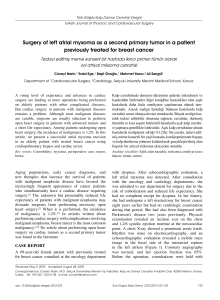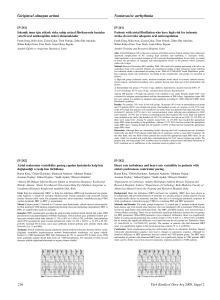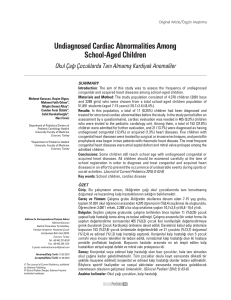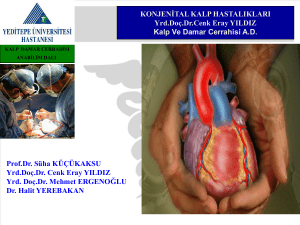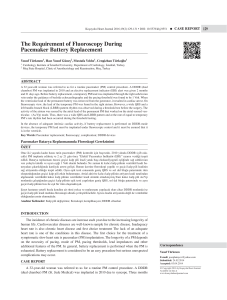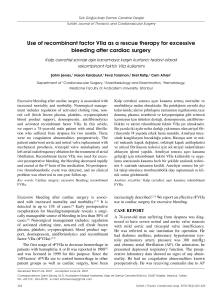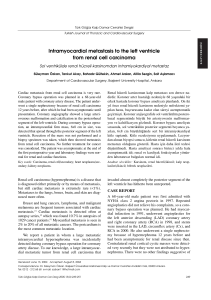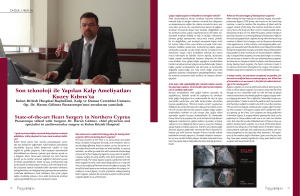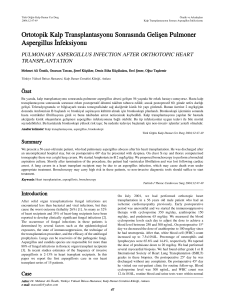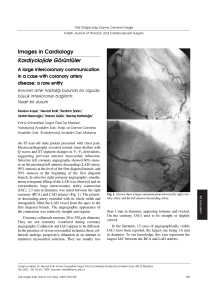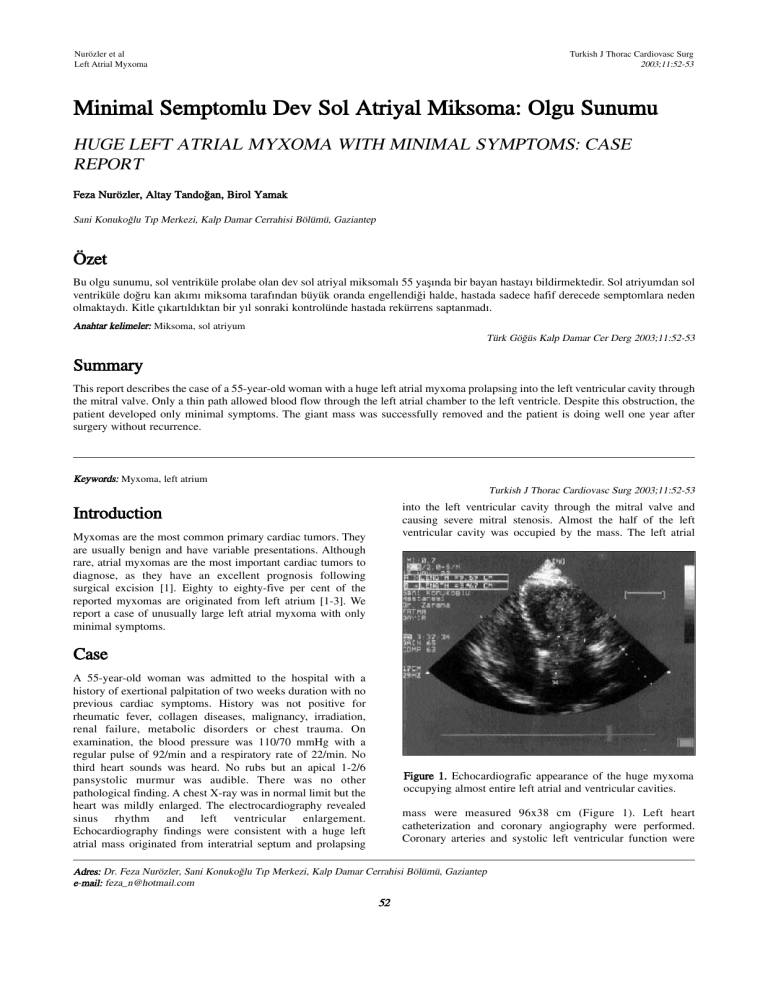
Nurözler et al
Left Atrial Myxoma
Turkish J Thorac Cardiovasc Surg
2003;11:52-53
Minimal Semptomlu Dev Sol Atriyal Miksoma: Olgu Sunumu
HUGE LEFT ATRIAL MYXOMA WITH MINIMAL SYMPTOMS: CASE
REPORT
Feza Nurözler, Altay Tandoðan, Birol Yamak
Sani Konukoðlu Týp Merkezi, Kalp Damar Cerrahisi Bölümü, Gaziantep
Özet
Bu olgu sunumu, sol ventriküle prolabe olan dev sol atriyal miksomalý 55 yaþýnda bir bayan hastayý bildirmektedir. Sol atriyumdan sol
ventriküle doðru kan akýmý miksoma tarafýndan büyük oranda engellendiði halde, hastada sadece hafif derecede semptomlara neden
olmaktaydý. Kitle çýkartýldýktan bir yýl sonraki kontrolünde hastada rekürrens saptanmadý.
Anahtarr kelimelerr: Miksoma, sol atriyum
Türk Göðüs Kalp Damar Cer Derg 2003;11:52-53
Summary
This report describes the case of a 55-year-old woman with a huge left atrial myxoma prolapsing into the left ventricular cavity through
the mitral valve. Only a thin path allowed blood flow through the left atrial chamber to the left ventricle. Despite this obstruction, the
patient developed only minimal symptoms. The giant mass was successfully removed and the patient is doing well one year after
surgery without recurrence.
Keyyworrds: Myxoma, left atrium
Turkish J Thorac Cardiovasc Surg 2003;11:52-53
into the left ventricular cavity through the mitral valve and
causing severe mitral stenosis. Almost the half of the left
ventricular cavity was occupied by the mass. The left atrial
Introduction
Myxomas are the most common primary cardiac tumors. They
are usually benign and have variable presentations. Although
rare, atrial myxomas are the most important cardiac tumors to
diagnose, as they have an excellent prognosis following
surgical excision [1]. Eighty to eighty-five per cent of the
reported myxomas are originated from left atrium [1-3]. We
report a case of unusually large left atrial myxoma with only
minimal symptoms.
Case
A 55-year-old woman was admitted to the hospital with a
history of exertional palpitation of two weeks duration with no
previous cardiac symptoms. History was not positive for
rheumatic fever, collagen diseases, malignancy, irradiation,
renal failure, metabolic disorders or chest trauma. On
examination, the blood pressure was 110/70 mmHg with a
regular pulse of 92/min and a respiratory rate of 22/min. No
third heart sounds was heard. No rubs but an apical 1-2/6
pansystolic murmur was audible. There was no other
pathological finding. A chest X-ray was in normal limit but the
heart was mildly enlarged. The electrocardiography revealed
sinus rhythm and left ventricular enlargement.
Echocardiography findings were consistent with a huge left
atrial mass originated from interatrial septum and prolapsing
Figure 1. Echocardiografic appearance of the huge myxoma
occupying almost entire left atrial and ventricular cavities.
mass were measured 96x38 cm (Figure 1). Left heart
catheterization and coronary angiography were performed.
Coronary arteries and systolic left ventricular function were
Adrres: Dr. Feza Nurözler, Sani Konukoðlu Týp Merkezi, Kalp Damar Cerrahisi Bölümü, Gaziantep
e-m
mail: [email protected]
52
Türk Göðüs Kalp Damar Cer Derg
2003;11:52-53
Nurözler ve Arkadaþlarý
Dev Sol Atriyal Miksoma
patients without symptoms. Surgical resection of a single
myxoma is a safe and effective treatment, with a low risk of
recurrence [1-3]. The case reported here is atypical in that the
patient developed only minimal symptoms despite only a thin
path allowed blood flow through the left ventricle due to the
large size of the myxoma. In currently available English
literature, giant cardiac myxomas size up to 18x7x5 cm [6] and
weight up to 180 gram [7] have been reported, however to our
knowledge, atrial myxoma in that size without significant
symptoms has not been published.
normal.
The patient was taken to operation. A midline sternotomy was
performed. The ascending aorta and the bicaval cannulation
were completed. Cardiopulmonary bypass was established. The
left atrium was opened. A huge left atrial mass originated from
interatrial septum and occupying almost the entire left atrial
cavity was seen. The right atrium then was opened and
interatrial septum was incised around the fossa ovalis where the
mass was originated and the mass was taken out through left
atrial incision. The yellowish gelatinous mass was measured
120x50x30 mm. No remaining mass was inspected in left and
right heart chambers. Mitral valve was inspected and appeared
normal. All four cardiac chambers were explored for multiple
tumor or fragments of the myxoma. The mass weighted 172 g.
Microscopic examination of the mass revealed benign
myxoma. The postoperative course was uneventful and the
patient was discharged at the fifth postoperative day. The
patient is doing well one year after surgery without recurrence.
References
1. Keçecigil HT, Demir Z, Kolbakýr F, Demirað MK, Akar H.
Kardiyak miksoma ve cerrahi tedavisi. Türk Göðüs Kalp
Damar Cer Derg 1999;7:210-6.
2. Jelic J, Milicic D, Alfirevic I, et al. Cardiac myxoma:
Diagnostic approach, surgical treatment and follow-up. A
twenty years experience. J Cardiovasc Surg 1996;37:113-7.
3. Castells E, Ferran V, Octavio de Toledo MC, et al. Cardiac
myxomas: Surgical treatment, long-term results and
recurrence. J Cardiovasc Surg 1993;34:49-53.
4. Bjessmo S, Ivert T. Cardiac myxoma: 40 year’s experience
in 63 patient. Ann Thorac Surg 1997;63:697-700.
5. Meyns B, Vancleemput J, Flameng W, Daenen W. Surgery
for cardiac myxoma. A 20-year experience with long-term
follow-up. Eur J Cardiothorac Surg 1993;7:437-40.
6. Durgut K, Görmüþ N, Özülkü M, et al. Clinical features
and surgical treatment of cardiac myxoma: Report of 18
cases. Asian Cardiovasc Thorac Ann 2002;10:111-4.
7. Pinede L, Duhaut P, Loire R. Clinical presentations of left
atrial cardiac myxoma. A series of 112 concecutive cases.
Medicine 2001;80:159-72.
Discussion
Myxomas are the most common primary cardiac tumors. They
are usually benign and have variable presentations. Clinical
presentations varied from no symptoms and mild clinical signs
to various presentations. Jelic and assosiates [2] has reported
8.6% symptomless patients in their 81 patiens series. The
common symptoms include congestive heart failure, peripheral
embolization and syncopal episodes, however cardiac myxoma
may mimic many cardiovascular diseases, so a high index of
suspicion is important for its diagnosis [2,4,5]. Additionally
constitutional symptoms such as fever and weight loss may
accompany. Echocardiography is the most useful diagnostic
screening tool. The natural history of atrial myxoma is not well
establised. However, without surgical treatment, the medium
and long-term prognosis is considered fatal. Therefore once the
cardiac myxoma is identified by two-dimensional
echocardiography, the tumor should be removed even in
53

